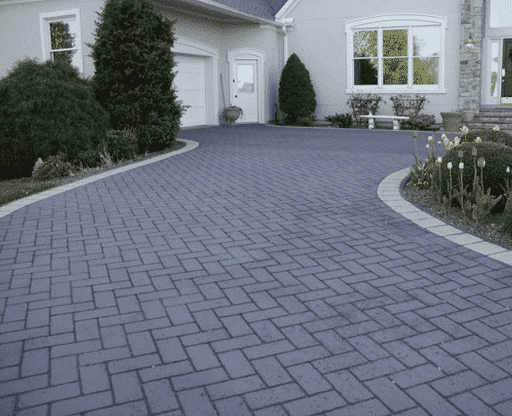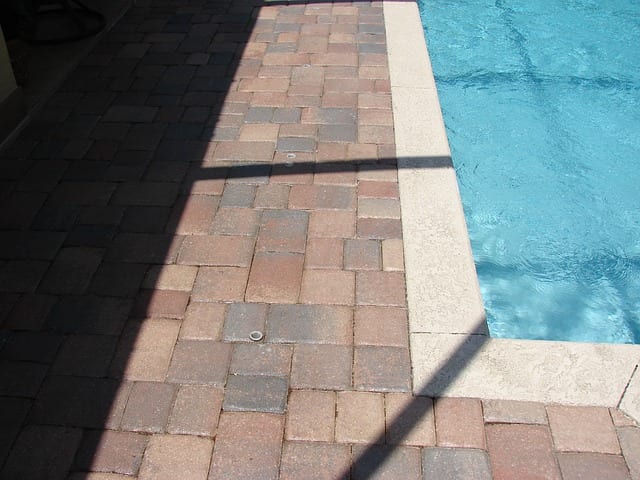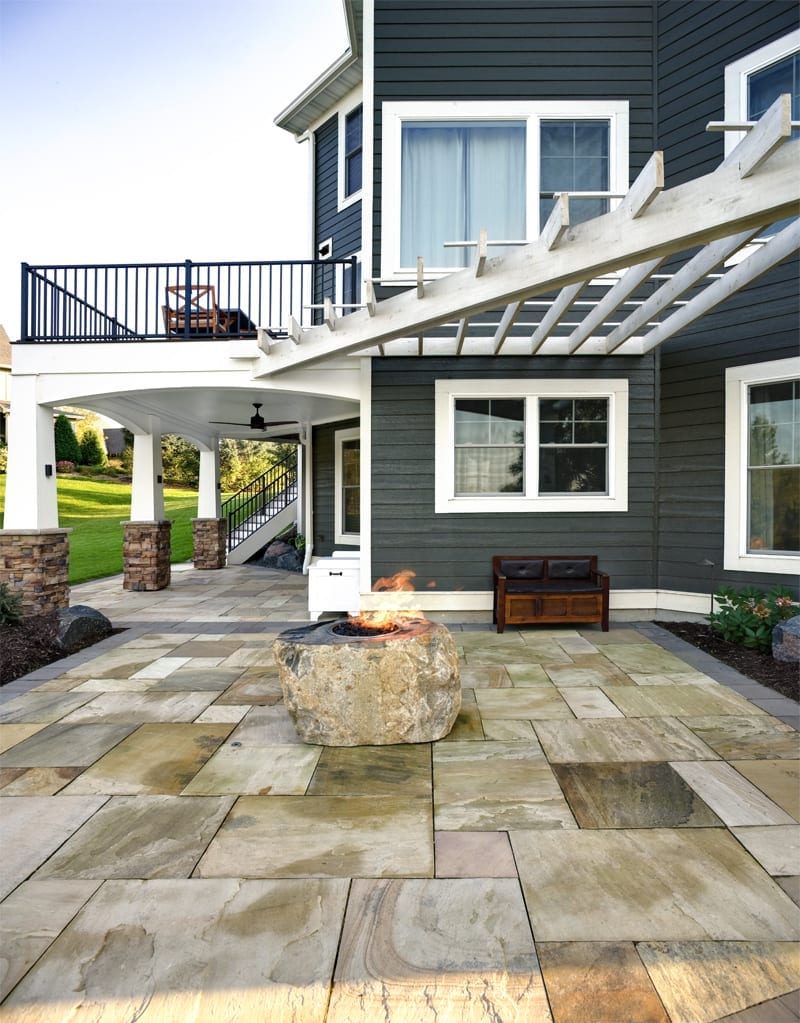
The charming brick paver streets of Midwestern and New England towns were installed more than a century ago. In Europe and other parts of the world, they date back thousands of years. The brick materials at the time could be wood or granite but for the most part, were clay pavers.
These paving installations gave way to more economical asphalt and concrete paving. In fact, many brick-paved streets were simply paved over with asphalt. Those clay pavers may have crumbled from the elements and years of wear but nevertheless proved a suitable base for less durable materials.
Modern brick paving saw a resurgence in the United States in the late 1980s with concrete brick pavers that had earlier gained widespread acceptance in Canadian cities.
Concrete brick pavers were initially designed to emulate the charm of clay brick pavers and granite cobbles. Nowadays there are many styles that are nearly indistinguishable from natural stone. One of the reasons for the widespread acceptance of concrete paver products is the more exacting standards that are back by the American Society of Testing Materials (ASTM).
These standards assure minimal water absorption and retention. People love the charm and rich colors of the traditional clay pavers, but their lack of durability typically limits their use to residential applications.
Concrete brick pavers have become the standard in Minnesota for withstanding the demands of freeze-thaw conditions. In addition to the paver materials, the installation methods and maintenance practices have also evolved to adapt to these demanding conditions.
If you are planning to invest or currently own a brick paver walkway, patio, or driveway, there are valuable insider secrets you should know for making the most of that investment. Additionally, you can enhance the beauty and longevity of your brick paver feature with simple periodic maintenance practices.
While the discussion that follows is relevant to most brick paver types, you can consider it to be written specifically with modern concrete brick pavers in mind. Additionally, it is assumed that basic practices such as pitching the paving installation to grade for proper drainage are followed.
Choosing Paver Types and Design Patterns
Every brick paver installation should be expected to last for years to come. To achieve this outcome it’s vital to consider the factors that contribute to this goal.
- PAVER STYLES
Brick pavers that interlock tightly provide the strongest finished product because every paver in that patio, walkway, or driveway installation contributes to its overall strength. Every finished paver installation is a unit that is only as strong as its weakest link.
Therefore, rectangular pavers will be stronger than pavers with rounded edges because the geometric shape allows for a tighter fit. Of course, larger pavers will be more stable than smaller pavers.
- INSTALLATION PATTERNS
The classic herringbone paver pattern (see photo above) is one of the strongest because there are no linear lines as there are with other patterns, such as running bond. When forces are applied to a paver installation, such as walking or driving, they are distributed from one brick the next and against the paver system edge until it dissipates.
When there are long, linear joints or seams within a paver installation forces received are greater along them and therefore not evenly distributed. This causes the paver installation to loosen up over time.

Building a Stable Base and Secure Edges
When concrete pavers were first introduced the recommended practice was to lay a base of several inches of sand and compare the pavers into it. We’ve come to learn that a crushed gravel aggregate base with a think layer of sand is more durable.
- PROPERLY COMPACT THE RIGHT BASE MATERIALS
Crushed aggregate gravel is comprised of angular pieces that naturally bind when compacted. Sand, on the other hand, is more likely to move over time due to impact forces and the influx of moisture. Therefore, it’s always best to use minimal sand and the most angular sand that is locally available.
When the crushed base is compacted be sure it is done in small layers, better known as lifts. No more than two inches of base material should be compacted in each lift. One of the reasons concrete walks and drives frequently crack is the base is nearly always compacted with a single lift.
Multiple lifts work together as a team to provide a unified base that is stronger than the respective layers. It is no different than a carpenter building a beam from multiple boards to create a much stronger element.
A brick paver base is ideally a minimum of 4-6 inches of crushed aggregate for a patio and 6-8 inches for a driveway. It may also have a fabric substrate beneath it to keep it intact, as opposed to moving with the solid when they take on excessive moisture.
- BRICK PAVER EDGES HOLD THE SYSTEM TOGETHER
Brick paver systems are expected to work together as a single unit. During our Minnesota winter freeze-thaw conditions, a single unit can successfully float slightly up and down or laterally while staying intact.
Compare this to an asphalt or concrete system. Asphalt is more flexible and less likely to crack than concrete, but the flexible joints of brick paver systems give them even more flexibility.
To be clear, brick paver systems are flexible units whose integrity is lost if any of the edges are compromised. Just as it took hours for the Titanic to collapse after the impact of an iceberg, so it is with brick paver installations that start to unravel.
If someone drives over the edge of a brick paver driveway the edge must be restored quickly. It only takes one rainstorm for sand and aggregate to be loosened, shift, and escape. Since every paver is connected to and supports its neighbor, it is then like a chain of dominoes ready to fall.
To ensure the strongest edge possible it should be anchored in a proper base. When the brick paver base does not extend well beyond the installation, the edge cannot be securely anchored to it and the entire system is compromised.
Finishing Methods and Maintenance Practices
The typical finishing practice of brick paver installations is sweeping sand into the joints. This secures that network of brick pavers with a flexible joint (like a concrete expansion joint) that allows the pavers to move slightly to adapt to environmental forces.
Joint sand inevitably blows or washes away and must be replenished. A recent and more sustainable solution is using polymeric sand that locks into the joint, giving it flexibility but resisting washout.
Finally, notwithstanding the advancements of modern brick pavers, the reality is that they will absorb a small amount of moisture and the colors will fade over the years. Both of these conditions can be mitigated by annually sealing the finished product.
There are many types of sealers and not all are recommended for every brand of brick pavers. It is best to check with the paver manufacturer for your particular installation and use.
The key to creating a beautiful, long-lasting brick paver installation is understanding its engineering for respective purposes. This provides valuable insights into its limitations and how to successfully navigate them.
Is there a hardscape problem you need to solve? Connect with Architectural Landscape Design, Inc., a residential design-build company serving the Minneapolis/St. Paul area.
We’ve been crafting outdoor living spaces for Minnesotans that work for more than two decades. Let’s talk about creating one just for you that is beautiful and adds significant value to your home.

